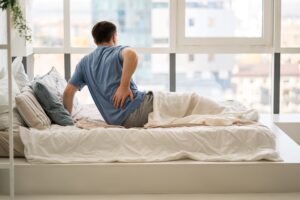If you have been plagued by spinal nerve pain and conservative techniques haven’t helped to provide relief, your spine specialist may recommend that you move forward with a decompression procedure. There are a number of different procedures that can decompress your spinal column based on your underlying needs, but one of the more common procedures is a lumbar laminectomy.
During this procedure, a portion of the spinal lamina is removed, which creates more space for key spinal nerves to travel through the spinal canal unimpeded. Many patients experience significant pain relief following the procedure, but you’ll want to be purposeful in your recovery if you want to give yourself the best chance at an optimal recovery. In today’s blog, we share some tips for recovering at home following your lumbar laminectomy procedure.
Recovering After Lumbar Laminectomy
Please remember that the following is just general advice, and you will be better served following the specific instructions of your operating surgery. With that said, odds are their recommendations will fall in line with many of the following recovery recommendations after a lumbar laminectomy.
- Get Up And Walk – You’re not going to be able to lay in bed for weeks and eventually make a full recovery. You need to push yourself physically to become the strongest version of yourself, and that begins with early movement. You may be stiff and sore after the procedure, but try to get up and move around a bit. This will help your spine become stronger and boost your circulation, but you also want to be careful not to push yourself too hard too soon after surgery. Gradually stand and walk more each day during your recovery.
- Mind Your Lifting Restrictions – We don’t realize how often we pick up and carry items each day until we have lifting restrictions. These lifting restrictions have been put in place for a reason, and lifting something heavy during a time when your spine is weak can lead to a setback. Don’t haul groceries or pick your toddler out of the crib if these actions are outside of your restrictions. Part of making a strong recovery involves avoiding setbacks.
- Limit Seated Time – Try to avoid sitting for extended periods of time in the days and week after your operation. Even if you’re only just standing and stretching for a minute or too, getting out of a seated position will help to alleviate static pressure that can wear down already weakened muscle groups after surgery. Make it a point to relieve static pressure that accumulates while sitting by standing once or twice an hour.
- Pursue Physical Therapy – Physical therapy will help the soft tissues that were damaged during surgery return to full strength, and it can work to restore normal range of motion in your spinal column. Physical therapy will help you become the strongest version of yourself after surgery, so don’t skip out on your sessions or your home-based exercises.
- Incision Care – As we talked about in the lifting restrictions section, part of a healthy recovery involves avoiding setbacks, and the most common setback after a surgical procedure is an infection. If you don’t care for your incision site or regularly change your dressings as recommended, you can increase your risk of an infection, which can compromise the integrity of the surgical procedure and lead to the need for a follow up operation. Follow your doctor’s instructions in regards to cleaning your incision site and how to keep the area protected in the shower.
- Eat A Healthy Diet – Finally, it’s helpful to consume a healthy diet at all times, but it’s especially helpful after a surgical procedure. Getting a range of important nutrients from your diet can give your recovering tissues the vitamins and minerals they need to heal correctly. A healthy diet will also help you avoid weight gain and make it easier for you to have more regular bowel movements, which can sometimes be thrown off as a result of surgery.
If you keep these tips in mind and trust your care to a skilled spine specialist like Dr. Jackman, we’re confident that you will be putting yourself in a good position to have a great recovery after a lumbar laminectomy. For more information, or to talk to Dr. Jackman about a different spinal issue, reach out to his office today at (651) 430-3800.


 Treating Neurogenic Claudication Caused By Spinal Stenosis
Treating Neurogenic Claudication Caused By Spinal Stenosis